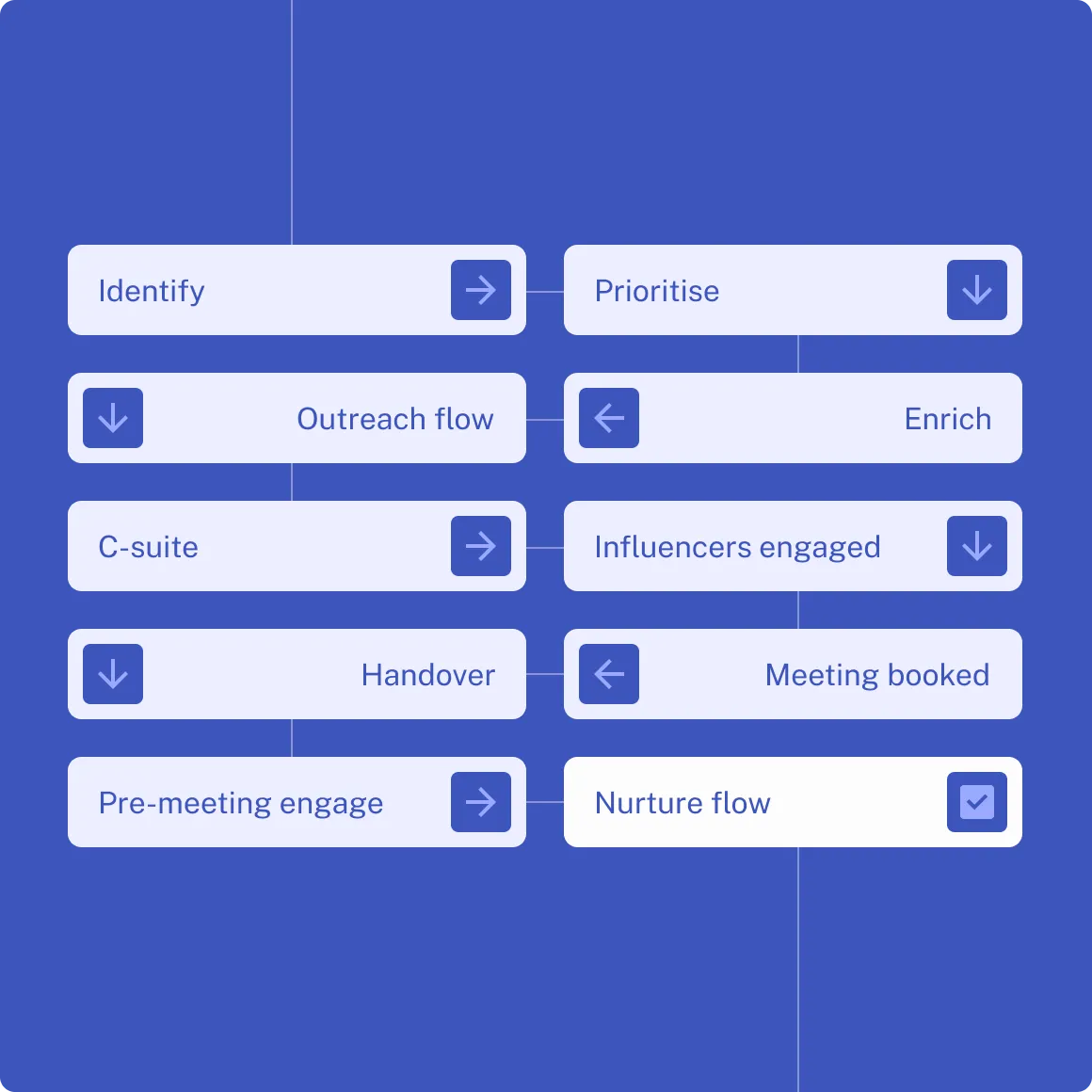Expert SDRs, powerful sales tech—your unfair advantage
Target entire buying committees at the perfect time, and engage them like no one else can.

Trusted by the worlds fastest growing brands












We fixed demand generation, no big deal. Sales evolved—whilst others are using yesterday’s playbook, our clients are converting 3X the industry average.
- Ongoing lead nurture and qualification
- Smart cadences that prevent pipeline decay
- Sales-ready opportunities delivered at the right time
- Flexible SDR resources without fixed costs
- Consistent performance from day one
- Risk-free market testing and pilot campaigns
- AI-powered account targeting
- Full buying committee engagement
- Higher conversion rates
- Local compliance and regional expertise
- Tested EMEA and US strategies
- Consistent quality across borders
- Smart technology identifies perfect-timing opportunities
- Expert SDRs deliver authentic, personalised engagement
- Proven 12X ROI delivery
Two powerful ways to transform your pipeline
Combine elite SDRs with precision timing to create predictable revenue growth.
SDR as a Service
Elite SDRs delivering qualified opportunities in 30 days.

Priority ABXTM
Know when accounts are ready to buy before your competitors do.

Stop chasing leads. Start building sustainable pipeline. Here’s how.
Build pipeline and drive results at every stage of your sales cycle with a blend of human SDRs and AI-powered sales tools that give your sales team an unfair advantage.

- We’ll leverage our global data warehouse to build your TAM
- Instant access to 100,000+ verified decision makers
- Create proven workflows that engage your ideal prospects

- Identify in-market accounts with Priority ABX™
- AI-powered prioritisation based on real-time buying signals
- Drive intent with targeted account-based advertising

- Engage entire DMUs with modern multi-threading strategies
- Multi-everything approach with prospecting by phone, email, video, LinkedIn, voice notes, ads and digital gifting
- Access to BarneyTM smart gifting platform to double meeting acceptance rates and accelerate deals

- Seamless meeting handovers with SDRs attending live
- Access to digital sales rooms that boost conversions by 3x
- Keep the buying committee engaged—our team nurtures internal champions and influencers to accelerate the deal
Keep opportunities moving from first touch to closed deal. Our SDRs handle pipeline nurturing while your sales team focuses on winning deals—delivering end-to-end revenue acceleration
Convert more opportunities into revenue with our expert SDR team. We blend proven methodologies with modern technology to deliver qualified opportunities that your sales team can close."
Maximize connection rates with advanced engagement strategies. From personalized video to strategic gifting, our comprehensive toolkit ensures higher meeting conversion rates.
Transform conversations into sales-ready opportunities. Our team handles qualification, scheduling, and prospect preparation—ensuring every sales conversation drives value.
Transform market signals into revenue opportunities with perfect timing. Our proprietary intelligence engine identifies and engages high-value accounts precisely when they're ready to buy.
Engage entire buying committees simultaneously through strategic outreach. Our coordinated approach builds consensus across decision-makers, accelerating your sales cycle.
Scale personalised engagement while eliminating routine tasks. Our AI technology enhances human intelligence—enabling your team to focus on high-value interactions.
Access elite SDRs trained through our rigorous 6-week program. Continuous coaching ensures consistent excellence in pipeline development and brand representation.
Reach decision-makers instantly with verified, up-to-date contact data. Our global database of 100,000+ enriched profiles ensures you connect with the right prospects every time.
Reach prospects where they're most responsive through orchestrated phone, email, video, and social outreach. Our coordinated approach ensures higher engagement rates across all channels
Double meeting attendance rates with perfectly timed strategic gifts. Our proprietary Barney™ platform creates memorable touchpoints that accelerate deal velocity.
Generate sustainable pipeline growth targeting your ideal customers. Our data-driven approach delivers qualified opportunities that convert—focusing on quality over quantity.
The Punch! difference: results, not excuses
Traditional SDR agencies promise results but deliver headaches. We've rebuilt the entire approach to deliver what others can't—predictable pipeline growth you can trust.
- Inexperienced SDRs with minimal training
- Spam-like follow up emails that damage your brand
- Scatter-shot outreach that wastes resources
- AI-only automation that risks brand reputation
- Team that disappears after booking
- Risky compliance shortcuts
.webp)
- Expert SDRs with continuous development (3+ years average tenure)
- Strategic conversations that drive deals forward
- Data-driven targeting with Priority ABX™
- AI to assist SDRs, never replace them
- Full-cycle outbound team that joins your meetings
- Enterprise-grade compliance
Everything you need to know about pipeline success
Have more questions? We love talking strategy—book a call and let's discuss your specific goals.
Our streamlined onboarding process gets you up and running in 30 days, compared to the 11+ months it typically takes to build an in-house team. Your dedicated Client Manager handles everything from technical setup to SDR training, ensuring you start generating pipeline quickly and efficiently.
The best results come from companies with high-value offerings, aligned sales and marketing teams, and a commitment to sustainable growth. We work closely with your team to understand your unique value proposition, target the right decision-makers, and continuously refine our approach based on market feedback.
While results vary by industry, target market and the package you opt for, our clients typically receive 100+ qualified opportunities annually. We focus on quality over quantity, ensuring each lead matches your ideal customer profile. Recent results include 56 sales opportunities in 4 months for Lumi and 200+ leads for Nutritics in 7 months.
Priority ABX™ is our proprietary intelligence platform that combines AI-powered scoring with real-time buyer intent data. It tracks sales signals, funding announcements, and leadership changes to ensure we're reaching out to prospects at exactly the right moment, resulting in 30%+ meeting conversion rates.
We provide full-cycle support from first touch to closed deal, not just lead generation. Our unique "multi-everything" approach combines multi-threading, advanced gifting, and multi-channel outreach. Every client gets a dedicated team of native English-speaking experts with 3+ years average experience.
We specialise in B2B companies with complex sales cycles across technology, professional services, healthcare, and financial services. Our client roster includes industry leaders like AWS, Palo Alto Networks, Square, and DHL. We'll share relevant case studies from your specific sector.
Our SDRs complete a 6-week academy and receive weekly coaching. We use Priority ABX™ to identify in-market accounts and buying signals, ensuring perfectly timed outreach. Every lead is qualified against your specific criteria, with full visibility through regular reporting.
Absolutely! We encourage you to meet the team who'll represent your brand. Your SDRs aren't just trained professionals - they're passionate advocates fully immersed in your proposition. We'll arrange meetings with your dedicated Client Manager, Sales Development Manager, and SDRs during onboarding.
We recommend a 12-month partnership to optimise results and maximize ROI. While clients see initial results within 30 days, the real impact comes from refining messaging and building momentum over time. Many clients stay with us for years, scaling their programs as they see consistent results.
B2B outbound insights
Expert strategies to accelerate your pipeline—backed by real-world results
Want the unfair advantage?
Two powerful ways to transform your pipeline
Combine elite SDRs with precision timing to create predictable revenue growth.

Outsourced SDR
Elite SDRs delivering qualified opportunities in 30 days.


Priority ABXTM
Know when accounts are ready to buy before your competitors do.












































